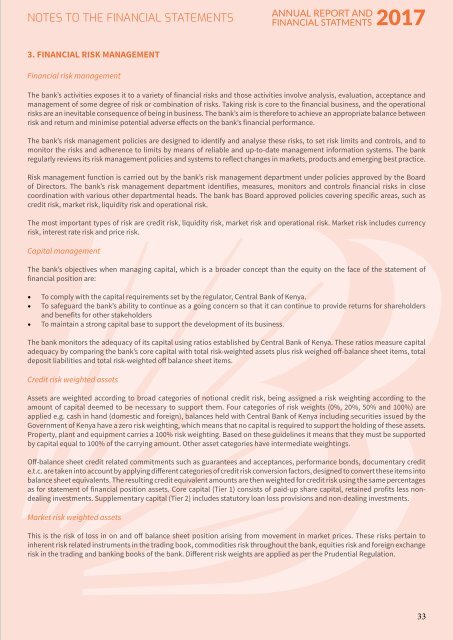BOB_2017_SMALL
You also want an ePaper? Increase the reach of your titles
YUMPU automatically turns print PDFs into web optimized ePapers that Google loves.
NOTES TO THE FINANCIAL STATEMENTS<br />
ANNUAL REPORT AND<br />
FINANCIAL STATMENTS <strong>2017</strong><br />
3. Financial risk management<br />
Financial risk management<br />
The bank’s activities exposes it to a variety of financial risks and those activities involve analysis, evaluation, acceptance and<br />
management of some degree of risk or combination of risks. Taking risk is core to the financial business, and the operational<br />
risks are an inevitable consequence of being in business. The bank’s aim is therefore to achieve an appropriate balance between<br />
risk and return and minimise potential adverse effects on the bank’s financial performance.<br />
The bank’s risk management policies are designed to identify and analyse these risks, to set risk limits and controls, and to<br />
monitor the risks and adherence to limits by means of reliable and up-to-date management information systems. The bank<br />
regularly reviews its risk management policies and systems to reflect changes in markets, products and emerging best practice.<br />
Risk management function is carried out by the bank’s risk management department under policies approved by the Board<br />
of Directors. The bank’s risk management department identifies, measures, monitors and controls financial risks in close<br />
coordination with various other departmental heads. The bank has Board approved policies covering specific areas, such as<br />
credit risk, market risk, liquidity risk and operational risk.<br />
The most important types of risk are credit risk, liquidity risk, market risk and operational risk. Market risk includes currency<br />
risk, interest rate risk and price risk.<br />
Capital management<br />
The bank’s objectives when managing capital, which is a broader concept than the equity on the face of the statement of<br />
financial position are:<br />
• To comply with the capital requirements set by the regulator, Central Bank of Kenya.<br />
• To safeguard the bank’s ability to continue as a going concern so that it can continue to provide returns for shareholders<br />
and benefits for other stakeholders<br />
• To maintain a strong capital base to support the development of its business.<br />
The bank monitors the adequacy of its capital using ratios established by Central Bank of Kenya. These ratios measure capital<br />
adequacy by comparing the bank’s core capital with total risk-weighted assets plus risk weighed off-balance sheet items, total<br />
deposit liabilities and total risk-weighted off balance sheet items.<br />
Credit risk weighted assets<br />
Assets are weighted according to broad categories of notional credit risk, being assigned a risk weighting according to the<br />
amount of capital deemed to be necessary to support them. Four categories of risk weights (0%, 20%, 50% and 100%) are<br />
applied e.g. cash in hand (domestic and foreign), balances held with Central Bank of Kenya including securities issued by the<br />
Government of Kenya have a zero risk weighting, which means that no capital is required to support the holding of these assets.<br />
Property, plant and equipment carries a 100% risk weighting. Based on these guidelines it means that they must be supported<br />
by capital equal to 100% of the carrying amount. Other asset categories have intermediate weightings.<br />
Off-balance sheet credit related commitments such as guarantees and acceptances, performance bonds, documentary credit<br />
e.t.c. are taken into account by applying different categories of credit risk conversion factors, designed to convert these items into<br />
balance sheet equivalents. The resulting credit equivalent amounts are then weighted for credit risk using the same percentages<br />
as for statement of financial position assets. Core capital (Tier 1) consists of paid-up share capital, retained profits less nondealing<br />
investments. Supplementary capital (Tier 2) includes statutory loan loss provisions and non-dealing investments.<br />
Market risk weighted assets<br />
This is the risk of loss in on and off balance sheet position arising from movement in market prices. These risks pertain to<br />
inherent risk related instruments in the trading book, commodities risk throughout the bank, equities risk and foreign exchange<br />
risk in the trading and banking books of the bank. Different risk weights are applied as per the Prudential Regulation.<br />
33




